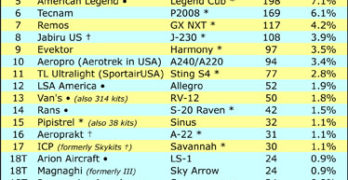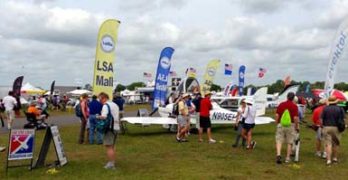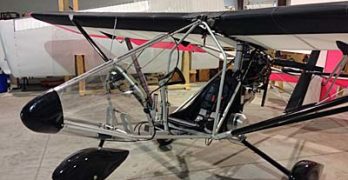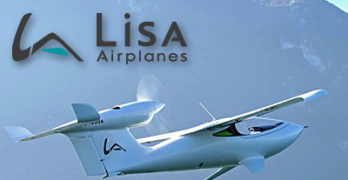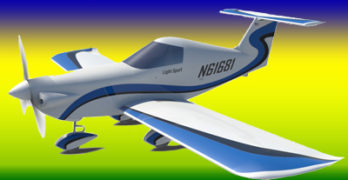As spring approaches and with major airshows like Aero Friedrichshafen in Germany and Sun ‘n Fun in Florida about to trigger a new season of recreational flying, it is time for an annual update of Light-Sport Aircraft market shares. Our well-known “fleet” chart appears nearby; this table refers to all Special LSA registered with FAA in the United States since the first aircraft was accepted by FAA almost ten years ago (on April 5, 2005).
We again post our Calendar 2014 tally that shows the success only in that year as a means of drawing attention to those brands and models performing the best in the last twelve months. We remind you that these charts use as their source the FAA registration (N-number) database, that is then carefully studied and corrected to make the most reliable report possible. However, two points: (1) this report will still have some errors as the database on which we rely has some faulty information … though we believe this to be modest and, as noted, we correct it where we can; and, (2) aircraft registrations are not likely to be perfectly in sync with company records of sales for a variety of reasons.
Search Results for : powered parachute
Not finding exactly what you expected? Try our advanced search option.
Select a manufacturer to go straight to all our content about that manufacturer.
Select an aircraft model to go straight to all our content about that model.
LSA Mall at Sun ‘n Fun 2015
We are less than two months away from Sun ‘n Fun 2015 where once again the LSA Mall will be a central part of the fascinating area called Paradise City. Here is where thousands of visitors to the large season-starting event can see a flock of Light-Sport Aircraft and light kit aircraft. Prospective customers for these airplanes can also take a demonstration flight, right on the show grounds of Sun ‘n Fun. See any vendor to inquire about demo flight availability.
At this 41st running of the popular event in Lakeland, Florida, LAMA, the Light Aircraft Manufacturers Association is pleased to again showcase the newest sector in aviation. Visitors can enjoy the third year of the completely redesigned Paradise City, formerly known to enthusiasts as the Ultralight or Lightplane Area. Transformed in 2013 with an entirely new layout that brings visitors closer than ever to a wide variety of aircraft, Paradise City is particularly popular as you can get intimately close to the runway where a wide variety of flying machines will take off and land almost all day long (except during certain parts of the main airshow in the mid-afternoon).
Is a Four Stroke Part 103 Airplane Possible?
Some people have long believed that Part 103-legal weight shift trikes or single place powered parachutes may be possible but I’ve often heard the pronouncement, “You cannot make a legal three axis Part 103 airplane.” I wonder if those folks are ready to admit their error?
Those attending the 2015 Sebring Expo will want to examine the new Aerolite 103 with a Briggs and Stratton four stoke, all freshly mounted and looking better than ever. That you can fly such an airplane without a pilot’s license or medical, without N-number registrations, and buy one ready-to-fly for an affordable price amazes more than a few pilots. However, mostly those machines — a few have been available for some time — use two stroke engines in order to stay within the very confining 254 pounds of empty weight. If you don’t care for two stroke power …Wait no more!
You might remember seeing such a machine at Sun ‘n Fun 2014.
Viking Engine Wins STOL Competition & Customers
Engine suppliers must love Zenith Aircraft, perhaps as much as their many airframe owners. For 23 years, the kit company based in Mexico, Missouri has supplied about 200 kits per year to buyers all over the country and around the world. That is a selling performance any light airplane company would like to boast. One reason for their success is their support of a variety of engines, no small feat considering each engines has special qualities to be considered when installing and using them. Good for Zenith for going the extra mile. One of the many engines they support is the Viking Aircraft Engine from Edgewater, Florida on the Atlantic side of the Sunshine State. Zenith also supports engines from Rotax, Jabiru, UL Power, and Continental. See the video below covering the short field takeoff and landing competition on a pretty, sunny day at the Mexico airport.
Amazing LSA Seaplanes: Lisa’s Supersleek Akoya
We just passed September 1st and that date is significant in the LSA universe. It is the day, ten years ago, that the Sport Pilot & Light-Sport Aircraft rule we have been celebrating all summer officially became part of the Federal Aviation Regulations (FARs). If you’re thinking, “Hey, I thought it was announced in the summertime, at AirVenture!” … you’re correct. It was, but that was just the administrator’s public relations timing to get the biggest bang for the buck, at Oshkosh. As we continue the tenth anniversary celebration — looking back on the first decade — we see the astounding development of 136 models of LSA, more than one every month for ten years running. This profusion of models runs the length and breadth of aviation, from fixed wing, three axis airplanes to powered parachutes to trikes to motorgliders and from less than $30,000 to over $200,000. I fully expect designers to continue pushing the envelope in every direction but one facet of LSA development seems as energized as a Saturn V moon rocket: LSA seaplanes.
Evektor with Dynon Earns EASA Type Certificate
The very first aircraft ever to receive approval in the USA as a Light-Sport Aircraft is Evektor-Aerotechnik’s SportStar. No challenger can ever take away that title yet the company has continually developed this pioneeering airplane and recently achieved a new level of approval … one that alters the landscape in a way I predict we’ll see more as FAA’s Part 23 rewrite project progresses. “Following several months of certification process EASA has approved glass cockpit Dynon SkyView [as] SportStar RTC,” Evektor announced. RTC stands for Restricted Type Certificate. It is not identical the U.S. Part 23 Type Certificate — representing a somewhat lower level of government oversight — but a company earning this has to jump through many regulatory hoops. “SportStar RTC has become the first EASA certified aircraft approved with the SkyView glass cockpit [by proving] compliance with certification requirements of the EASA CS-LSA regulations. Dynon’s SkyView, recently upgraded to permit touch functionality, is widely known and used on Light-Sport Aircraft.
SkyCraft Airplanes Finishes ASTM Compliance
While so many continue to say you can’t buy a Light-Sport Aircraft for less than — pick a number … $100,000 … $150,000 — the truth is something else. We already have modestly priced entries from Quicksilver, BushCat, X-Air, M-Squared, plus several weight shift or powered parachute entries. Another that burst on the scene a couple AirVentures back was SkyCraft. The Czech design that a group in Utah are Americanizing is a fully enclosed, well-equipped single seater. Not many singles have been offered (Tecnam‘s aerobatic Snap is one such) yet the fact remain that much flying is done solo anyway, so why not have a sharp airplane for your own aerial enjoyment. Plus, what if you can fly it away for less than $60,000? Not every pilot will find SkyCraft SD-1 Minisport sufficient and lucky for those aviators, plenty of choices are available if you have to have 1,000-mile range, autopilot, big dual glass instrument panels, and of course, two seats.
Happy Birthday Sport Pilot / Light-Sport Aircraft!
Some may find it hard to believe that ten years have passed since FAA made its grand announcement introducing the Sport Pilot / Light-Sport Aircraft regulation. Others may see it differently. Some thought the rule was a long while coming. A number of people gave of their time to an ARAC (Aviation Rulemaking Advisory Committee) that deliberated for more than ten years prior to the 2004 announcement. What started out as a means to expand ultralight aircraft and to “fix” certain problems that had arisen ended up doing something completely different … although some in the agency maintain they did fix the “fat,” or two seat “ultralight problem.” Many insiders didn’t feel the problem got solved so much as got buried under other initiatives, but that’s a story for another article. What did emanate from the ARAC work and FAA’s lengthy internal deliberations was a game-changing method of approving aircraft and I, for one, salute the agency for its brave achievement.
2013 Light-Sport Market Share Report & Analysis
UPDATE: May 27, 2014 — “A vigorous debate ensued …” might be one way to refer to a four-way discussion from around the globe. Over the last few days, LSA industry folks in distant lands worked on market share details. Michael Coates is the Australian-based U.S. distributor for Pipistrel, an aircraft fabricated in Slovenia and assembled as a LSA in nearby Italy for shipment to the USA. My Czech-based associate, Jan Fridrich, was in China again because his country works with that nation as they build a personal aviation sector virtually from scratch. From our corners of the world we tried to resolve a problem that regularly occurs in our study of the FAA registration database. Pipistrel maintained their SLSA airplane numbers were stronger. Jan and I communicated and finally agreed that we were underreporting their numbers. The chart below has been modified to reflect a truer situation, sharply moving Pipistrel upward from 20th to 14th rank.
The “Real” LSA Market & Future Growth
In talks I give at airshows, I’ve begun to focus on what I term the “real” LSA market. Many folks are confused and even our ByDanJohnson.com statistics and articles about market share ranking add to the fog obscuring the big picture. The chart below attempts to burn off that fog and provide a clearer understanding. However, the table — meant for use when I proceeded line by line in a live presentation — needs some explanations.
The chart attempts two tricks. The first goal was to contrast general aviation (GA) with Light-Sport aviation. We compare only to single engine piston GA aircraft as we saw that as the closest match. So the chart has at top left, a figure of 790, which is the number of Type Certified general aviation aircraft delivered in 2012, the latest full year of information at the time of the chart’s creation. Come down one line to see the total of Special LSA airplanes registered in 2012, again noting that LSA report registrations where the GA industry states deliveries; these two stats are not identical but are close enough for the purposes of this discussion.
- « Previous Page
- 1
- …
- 10
- 11
- 12
- 13
- 14
- …
- 45
- Next Page »


